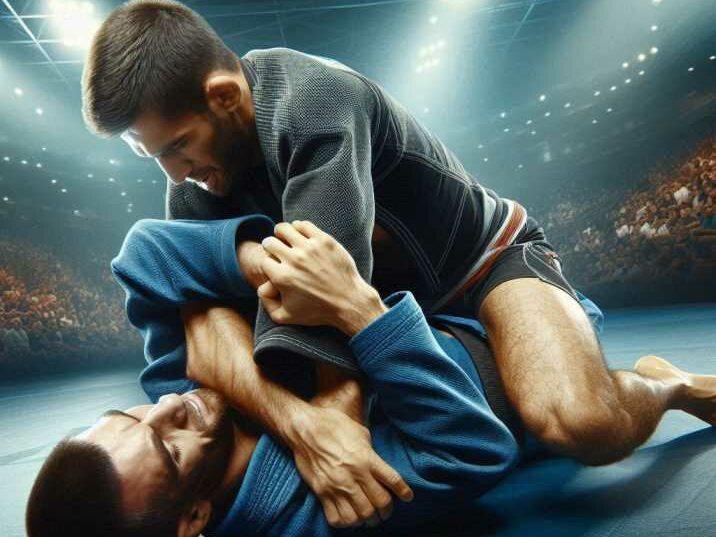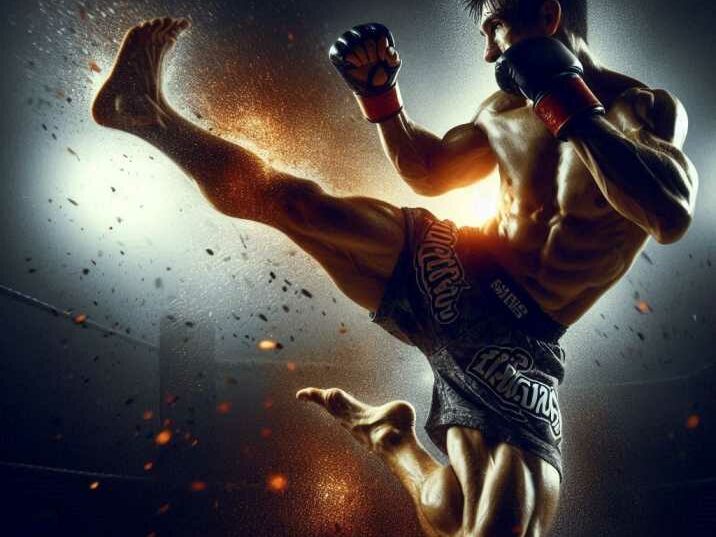Mixed Martial Arts (MMA) has become one of the fastest-growing sports in the world, MMA fighters use a combination of various martial arts techniques to outsmart and overpower their opponents. This article will delve deeply into the most common martial arts in MMA, explaining each one in detail in a way that’s easy to understand, even for grade 5 students.

Introduction
Table of Contents
MMA is a thrilling sport that combines techniques from various martial arts, creating a versatile and effective fighting style. This blend of disciplines makes MMA both exciting to watch and challenging to master. In this article, we’ll explore the most commonly used martial arts in MMA, how they contribute to a fighter’s skills, and highlight some notable fighters who excel in these arts.
Brazilian Jiu-Jitsu (BJJ)
What is Brazilian Jiu-Jitsu?
Brazilian Jiu-Jitsu (BJJ) is a martial art that focuses on ground fighting and submissions. It teaches fighters how to control their opponent and make them submit using joint locks or chokeholds. The primary philosophy of BJJ is that a smaller, weaker person can successfully defend against a bigger, stronger opponent by using leverage and proper technique.
Key Techniques in Brazilian Jiu-Jitsu
- Guard Position: This is a defensive position where the fighter on the bottom uses their legs to control the opponent on top. There are various types of guards such as closed guard, open guard, and butterfly guard.
- Mount Position: A dominant position where the fighter sits on the opponent’s chest. From this position, the top fighter can deliver strikes or set up submissions.
- Submission Holds: Techniques designed to force an opponent to submit by applying pressure to joints or by choking. Common submissions include the armbar, triangle choke, and rear-naked choke.
Famous MMA Fighters Known for BJJ
- Royce Gracie: One of the pioneers of MMA, showcasing the effectiveness of BJJ in early UFC events. His victories highlighted the importance of ground fighting.
- Demian Maia: Known for his exceptional grappling and submission skills, Maia has used his BJJ expertise to dominate many opponents in the UFC.
Training in Brazilian Jiu-Jitsu
BJJ training involves both gi (traditional uniform) and no-gi grappling. Practitioners learn various techniques, including sweeps, escapes, and transitions. Sparring, known as “rolling,” is a crucial aspect of BJJ training, allowing practitioners to apply techniques against resisting opponents.
Benefits of Brazilian Jiu-Jitsu
- Self-Defense: BJJ teaches effective techniques for controlling and subduing opponents, making it valuable for self-defense situations.
- Physical Fitness: BJJ training improves cardiovascular health, strength, flexibility, and coordination.
- Mental Discipline: Practicing BJJ requires focus, patience, and problem-solving skills, promoting mental toughness and discipline.
Muay Thai
What is Muay Thai?
Muay Thai, also known as the “Art of Eight Limbs,” originates from Thailand and is a striking martial art. It utilizes punches, kicks, elbows, and knee strikes, making it a very versatile form of combat. Muay Thai fighters are known for their toughness and ability to deliver powerful strikes from all angles.

Key Techniques in Muay Thai
- Striking: Using fists, elbows, knees, and shins to deliver powerful strikes. Muay Thai fighters often use combinations to overwhelm their opponents.
- Clinch: Controlling an opponent’s head and body to deliver strikes, particularly knees and elbows, or to set up throws. The clinch is a critical aspect of Muay Thai and is used to wear down the opponent.
- Defensive Maneuvers: Techniques to block or evade attacks, such as checking kicks with the shins or using the arms to block punches and elbows.
Famous MMA Fighters Known for Muay Thai
- Anderson Silva: Known for his striking precision and dominance in the UFC, Silva has a Muay Thai base that he uses effectively in his fights.
- Joanna Jędrzejczyk: A former champion renowned for her striking skills, Jędrzejczyk uses her Muay Thai background to outstrike her opponents.
Training in Muay Thai
Muay Thai training focuses on developing striking techniques, conditioning, and mental toughness. Practitioners train in pad work, sparring, and bag work to improve technique and timing. Clinch work and knee strikes are also emphasized to prepare fighters for close-range combat.
Benefits of Muay Thai
- Striking Power: Muay Thai training builds explosive power and endurance in striking techniques.
- Versatility: Muay Thai fighters are proficient at various ranges, from long-range kicks to close-range elbows and knees.
- Mental Resilience: Training in Muay Thai instills mental toughness and discipline, preparing fighters for the rigors of combat sports.
Wrestling
What is Wrestling?
Wrestling involves grappling techniques such as takedowns and control on the ground. There are different styles of wrestling, including Greco-Roman, which focuses on upper body techniques, and Freestyle, which allows attacks on the entire body. Wrestling is one of the oldest forms of combat and has a significant influence on MMA.
Key Techniques in Wrestling
- Takedowns: Techniques to bring an opponent to the ground, such as double-leg and single-leg takedowns. Takedowns are essential in controlling the pace and position of the fight.
- Control Positions: Maintaining dominance over an opponent once on the ground. This includes positions like the top mount and side control.
- Ground and Pound: Striking an opponent on the ground. Wrestlers use their control to keep the opponent down while delivering punches and elbows.
Famous MMA Fighters Known for Wrestling
- Khabib Nurmagomedov: Known for his relentless grappling and ground control, Khabib uses his wrestling background to dominate his opponents.
- Daniel Cormier: An Olympic wrestler turned MMA champion, Cormier uses his wrestling skills to control and defeat his opponents.
Training in Wrestling
Wrestling training focuses on takedowns, throws, and ground control. Practitioners drill techniques such as double-leg takedowns, single-leg tackles, and body locks. Sparring and live wrestling sessions allow wrestlers to apply techniques against resisting opponents.
Benefits of Wrestling
- Takedown Defense: Wrestling training teaches effective takedown defense, allowing fighters to stay on their feet and control the fight.
- Ground Control: Wrestlers excel at controlling opponents on the ground, preventing escapes and setting up strikes or submissions.
- Physical Conditioning: Wrestling workouts are intense and improve cardiovascular endurance, strength, and agility.
Boxing
What is Boxing?
Boxing focuses on using punches to strike an opponent. It emphasizes footwork, head movement, and defensive strategies to avoid getting hit. Boxing is a fundamental striking art in MMA, providing fighters with powerful and precise punching techniques.
Key Techniques in Boxing
- Jab: A quick, straight punch that is used to set up other strikes and keep the opponent at a distance.
- Cross: A powerful straight punch thrown with the dominant hand. It is often used in combination with the jab.
- Hooks and Uppercuts: Curved punches aimed at the side or below the opponent’s guard. Hooks target the side of the head or body, while uppercuts are aimed at the chin or torso.
Famous MMA Fighters Known for Boxing
- Conor McGregor: Famous for his knockout power and striking skills, McGregor’s boxing background has made him one of the most notable fighters in MMA.
- Holly Holm: A former professional boxer turned MMA fighter, Holm is known for her striking and footwork.
Benefits of Boxing
- Striking Accuracy: Boxing training enhances striking accuracy and precision, allowing fighters to land clean shots on their opponents.
- Footwork and Mobility: Boxers develop agility and footwork through drills that improve movement in the ring, enabling them to evade attacks and create angles for offense.
- Cardiovascular Endurance: Boxing workouts are intense and improve cardiovascular fitness, enabling fighters to maintain a high pace throughout the fight.
- Mental Toughness: Boxing requires focus, determination, and resilience, fostering mental toughness and discipline in fighters.
Judo
What is Judo?
Judo is a Japanese martial art that emphasizes throws and groundwork. It focuses on using an opponent’s force against them, making it highly effective in taking down and controlling opponents. Judo techniques are often used to transition from standing to ground fighting.
Key Techniques in Judo
- Throws: Techniques like hip throws and shoulder throws, used to off-balance and bring an opponent to the ground. Popular throws include the Osoto Gari (major outer reap) and Seoi Nage (shoulder throw).
- Pins: Holding an opponent down on the mat to immobilize them. Pinning techniques can lead to a dominant position or set up submissions.
- Submissions: Joint locks and chokeholds used to force an opponent to submit. Common submissions in Judo include the armbar and various choke techniques.
Famous MMA Fighters Known for Judo
- Ronda Rousey: Former UFC champion known for her judo throws and armbar submissions. Rousey’s judo skills made her one of the most dominant fighters in women’s MMA.
- Karo Parisyan: Known for integrating judo into MMA successfully, Parisyan used his judo background to execute impressive throws and submissions.
Training in Judo
Judo training focuses on developing throwing techniques, grappling skills, and falling techniques (ukemi). Practitioners drill throws from various grips and positions, learning to adapt to different scenarios. Randori (sparring) allows Judokas to practice techniques against resisting opponents.
Benefits of Judo
- Throwing Techniques: Judo teaches powerful throwing techniques that allow fighters to off-balance and control opponents.
- Ground Control: Judokas excel at controlling opponents on the ground, setting up submissions or transitioning to dominant positions.
- Balance and Coordination: Judo training improves balance, coordination, and proprioception, enhancing overall athletic performance.
- Respect and Discipline: Judo emphasizes respect, discipline, and mutual welfare, instilling important values in practitioners.
Karate
What is Karate?
Karate is a striking martial art from Japan that uses punches, kicks, and blocks. It emphasizes speed, precision, and discipline. Karate practitioners are trained to strike with maximum efficiency and power, using techniques that are both defensive and offensive.
Key Techniques in Karate
- Strikes: Punches and kicks aimed at vital points. Karate strikes are delivered with precision and speed to inflict maximum damage. Common strikes include the straight punch (Oi Zuki) and the roundhouse kick (Mawashi Geri).
- Blocks: Techniques to deflect or stop an opponent’s attacks. Blocks in Karate are designed to protect the practitioner while setting up counter-attacks.
- Katas: Patterns of movements practiced for form and technique. Katas are sequences of strikes, blocks, and movements that simulate combat situations, helping practitioners to develop their skills.
Famous MMA Fighters Known for Karate
- Georges St-Pierre: Known for his karate-based striking and athleticism, St-Pierre uses his karate skills to maintain distance and control the pace of his fights.
- Lyoto Machida: Utilizes karate for effective and unpredictable striking. Machida’s unique style makes him a challenging opponent in the octagon.
Training in Karate
Karate training involves kata (forms), kihon (basic techniques), and kumite (sparring). Practitioners focus on developing technique, speed, and power through repetitive drills and exercises. Kumite allows Karateka to apply techniques in a controlled, live environment.
Benefits of Karate
- Self-Defense Skills: Karate teaches practical self-defense techniques that can be used in real-life situations.
- Discipline and Focus: Karate training promotes discipline, focus, and mental fortitude, improving concentration and attention to detail.
- Physical Fitness: Karate workouts improve cardiovascular health, strength, flexibility, and coordination.
- Character Development: Karate emphasizes respect, humility, and perseverance, fostering positive character traits in practitioners.
Table of Information
| Martial Art | Origin | Key Techniques | Notable MMA Fighters |
|---|---|---|---|
| Brazilian Jiu-Jitsu | Brazil | Ground fighting, submissions | Royce Gracie, Demian Maia |
| Muay Thai | Thailand | Strikes with fists, elbows, knees, shins | Anderson Silva, Joanna Jędrzejczyk |
| Wrestling | Various (Greco-Roman and Freestyle) | Takedowns, control on the ground | Khabib Nurmagomedov, Daniel Cormier |
| Boxing | USA | Punches | Conor McGregor, Holly Holm |
| Judo | Japan | Throws, groundwork | Ronda Rousey, Karo Parisyan |
| Karate | Japan | Strikes, blocks, kicks | Georges St-Pierre, Lyoto Machida |
Conclusion
MMA is a dynamic sport that draws from a diverse range of martial arts disciplines. Each martial art contributes unique techniques and strategies, making MMA an exciting and evolving combat sport. By understanding the fundamentals of Brazilian Jiu-Jitsu, Muay Thai, Wrestling, Boxing, Judo, and Karate, fans and aspiring fighters can gain a deeper appreciation for the skills and techniques involved in MMA competition. Whether it’s controlling opponents on the ground, delivering powerful strikes, or executing precise throws, each martial art plays a vital role in shaping the modern MMA fighter.
FAQs
1. What martial art is best for MMA?
There is no single best martial art for MMA. Success in MMA requires a combination of different martial arts to cover striking, grappling, and submissions.
2. Why is Brazilian Jiu-Jitsu important in MMA?
Brazilian Jiu-Jitsu is crucial because it allows fighters to control and submit their opponents on the ground, which is a key aspect of MMA.
3. How does wrestling help in MMA?
Wrestling helps fighters control where the fight takes place, either by taking opponents down to the ground or preventing takedowns.
4. Can a boxer be successful in MMA?
Yes, a boxer can be successful in MMA, especially if they learn to defend against takedowns and incorporate other martial arts techniques.
5. What makes Muay Thai effective in MMA?
Muay Thai is effective because it teaches powerful striking techniques using all parts of the body, making it versatile and deadly in close combat.


